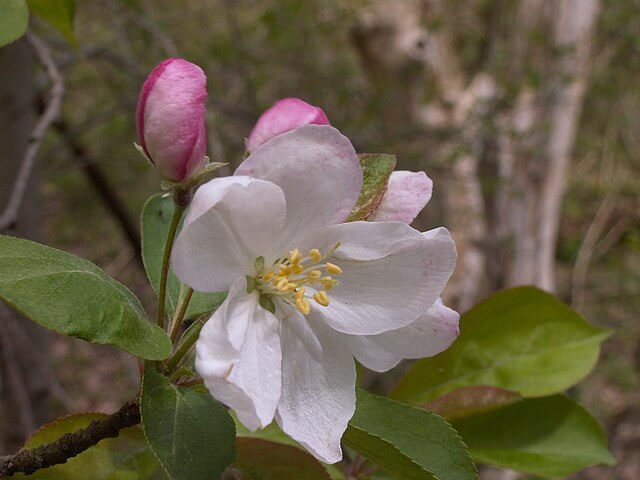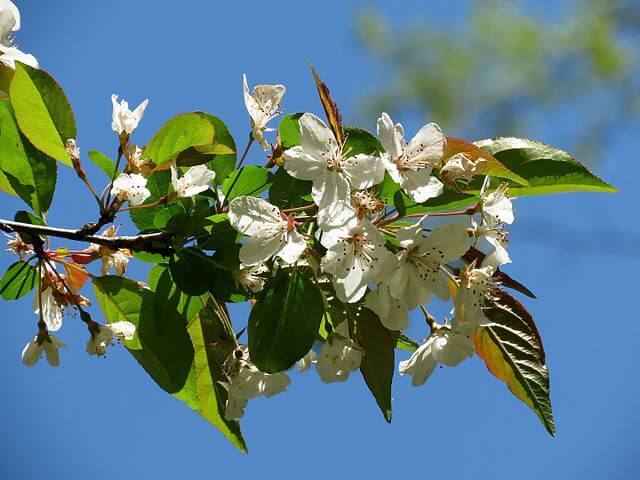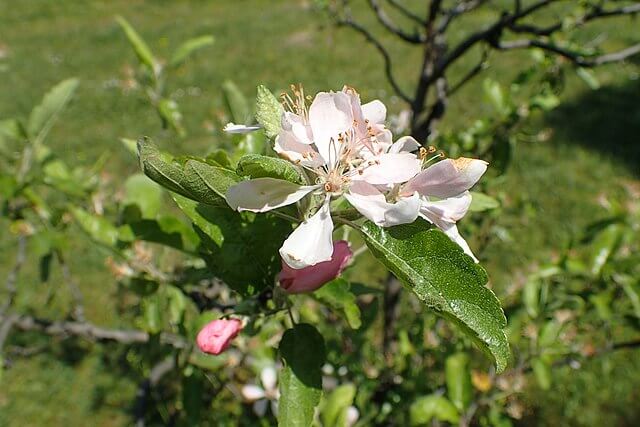Standing proud at the edge of woodlands, disguised in the hedgerows of old farmed fields or perched along a hiking trail. Native North American apple trees are a fantastic fruit to stumble across whilst out exploring. These native wild apples are edible and full of flavor, although some can be particularly bitter! You can collect them for jam or cider making, or even snack on them during a camping trip by roasting them by the fire. Generally, the more bitter they are, the better they would be for making great cider!

A native species resides in different climates and altitudes throughout North America, and they’re fairly common. However they mainly prefer a temperate climate, and are more common in the Northern states. Whether in the woodlands of Oregon or prairies of Missouri.
How Are Native Wild ‘Crabapples’ Different to Orchard or Supermarket Apples?
Crabapples are the ancestors of the common apples that farmers grow in orchards, and that we choose from shop shelves. Like many common fruits, vegetables and spices (for example wild lettuce and wild strawberries!), we have domesticated apples from species that originated in the wild. Generally crabapple trees have small fruits, usually considered to be about 2 inches in diameter or smaller. You can read more about the differences between crabapples and domestic apples here!
The Four Native Crabapple Species of North America
The native apple species you find out in the wild today may not always be a guaranteed, true species. The native wild apples of North America have hybridized with the European apple species brought over when colonizers first arrived. Plus, they can even hybridize with ornamental apples that we plant in our gardens. Like the beautiful pink showy flowers on the ‘Prairiefire’ cultivar, or the ‘Red Sentinel’, with its bright red fruits.
The Sweet Crabapple (Malus coronaria)

You’ll find this sweetly named crabapple growing in the Great Lakes Region, particularly in Ohio and Michigan. It’s great for making jams and jellies, as well as cider and apple cider vinegar. The fruits are a yellow green color and usually about 1 to 2 inches in diameter. The flower buds are pink, but when open the petals are a very delicate light pink color.
The apples were prepared and eaten by Native Americans, and also European colonisers. Native Americans created healing recipes with infusions of the bark and roots of the Sweet Crabapple.
The Oregon/Pacific Crabapple (Malus fusca)
As the name suggests, you’ll find the Pacific Crabapple along the western pacific states. The flowers are a very pale pink, almost white, and it’s often a popular choice as a garden ornamental. The red/yellow fruits are quite sour, so are best suited to making preserves, pies or cider!

Many native American populations foraged crabapples, as a source of food and also medicine. The Oregon crab apple fruits were gathered and eaten raw or cooked. Whilst the bark and wood were collected to create tools, or to be used in different medicinal infusions.
The Southern Crabapple (Malus angustifolia)
Keep an eye out for the Southern Crabapple in low altitude areas in the south eastern and south central states. You’ll find them along streams or at the edges of woodland. Look out for the light pink to white, fragrant flowers which bloom in early spring. The tree is fairly similar to the Sweet Crabapple. However its leaves are generally longer and narrower, and with a more rounded end.
Again, the fruits are on the sour side, so try roasting them first, or making a jam! If foraging, make sure to not over-harvest, as wildlife depend on the fruits, and the species itself is considered threatened. The fruits are a golden green/yellow color, and tend to be just over an inch in size.

The Prairie Crabapple (Malus ioensis)
With delicate pink flowers that bloom in late spring, you’ll find the Prairie Crabapple growing in the central plains of the upper Mississippi valley. Because of its large, fragrant and showy flowers, its often a popular parent plant for some ornamental crabapple cultivars.
The apples are small and usually green, even when ripe. It has a very similar appearance to the Sweet Crabapple from the Great Lakes Region. However you can generally tell them apart by the fine hairs present on the Prairie Crabapple.

Why are Crabapples called ‘Crabapples’?
The history of the name given to wild apples is not completely certain. Some people believe it could be linked to an old Celtic word for ‘fruit of the wild apple tree’ which is ‘skrabba’. Others suggest it could have originated from an old middle English word known as ‘crabbed’. The definition meaning ‘small’ and generally contorted, which could refer to the crooked branches and the small fruits.
Native Wild Apples and Wildlife
A huge variety of wildlife are dependent on wild apples trees, from bears to caterpillars. The trees provide nesting sites and refuge for many small animals, and the fruits are eaten too. So if you’re out foraging for apples to make crabapple jam, make sure to leave some behind for your local wildlife!
—————Written by Hannah Sweet
Hannah is a freelance writer and graphic designer from the UK. With a penchant for travelling, photography and all things botanical, she enjoys writing about a wealth of topics and issues, from conservation and slow living, to design and travel. Learn more about her writing and design services at www.sweetmeanders.co
Many of our readers find that subscribing to Eat The Planet is the best way to make sure they don't miss any of our valuable information about wild edibles.
See our privacy policy for more information about ads on this site







4 Responses
I think you mean western.
“The Oregon/Pacific Crabapple (Malus fusca)
As the name suggests, you’ll find the Pacific Crabapple along the eastern pacific states.”
oh thanks a lot, that was a typo. I’ll correct it.
Hey, should I worry about hybrids of grocery store bought apples and crabapples? I do not want to risk biodiversity loss.
Thank you for the article!
I am not new to Apples,, been eating and keeping track records on many of them,
At one time the Golden delicious was my Favourite,
But I ran into a hybird which I have found quite interesting, The Cosmic Crisp from washinton state,this apple holds ten seeds per apple, This apple is quite tasty, I have enjoyed them.
I have not tried the native cranapple yet,, I have been reading up on them, sounds like a real nice apple for making Jam..I am looking forward to planing a few trees to see how they grow into different climates.
would love any information on a native apple,,If anyone would like to share,